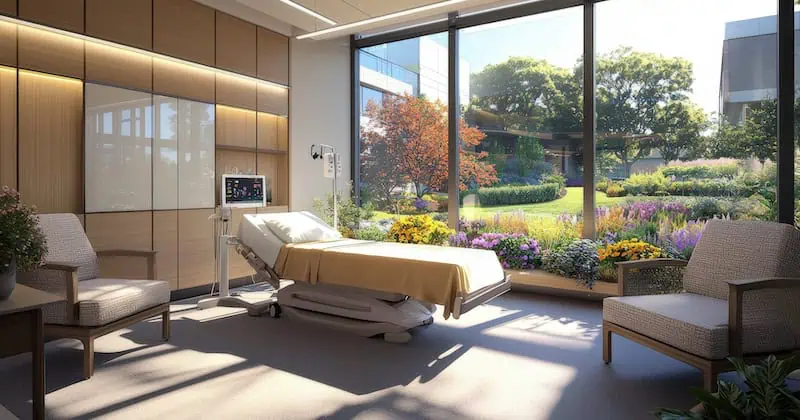Facilities Teams Are Becoming The New Patient Experience Champions

Traditionally seen as the behind-the-scenes operators of hospitals, today’s facilities management (FM) teams are stepping into a new spotlight — becoming key players in enhancing the patient experience. In collaboration with clinical staff, infection control experts, and design professionals, facilities leaders are helping shape healing environments that meet regulatory demands and make patients and families feel safe, calm, and cared for.
This evolution is more than just a shift in job description — it’s a reflection of a growing awareness that patient perception begins before a nurse is ever seen or a test is run.
“Cleanliness makes or breaks it from the start,” said Leah Hummel, who has worked extensively at the intersection of healthcare design and facilities. Hummel recalls when HCAHPS (Hospital Consumer Assessment of Healthcare Providers and Systems) scores — tied to hospital reimbursements — first launched. “It all started with cleanliness, and that’s still the first thing people notice.”
But today, patient experience has expanded well beyond sparkling floors. Facilities teams are now expected to consider how light, air, noise, temperature, and even privacy impact healing. “Hospital FMs work hand in hand with hospital services to prioritize patient comfort, manage regulatory standards, and support staff wellness,” Hummel explained.
Jeffrey O’Neill, VP of Facilities, Design, and Construction at Rutgers University, agreed. “Creating a positive patient experience has always been a part of our vocabulary,” he said. “The big difference is that today’s facilities team leaders are taking a close look at survey comments to make major changes in many areas ranging from tactile improvements to accelerating the time it takes to prepare rooms for patients.”

Mimicking Nature Indoors
The benefits of natural light and fresh air are well-documented. Research in the Journal of Sleep Research has shown that access to sunlight and fresh air improves sleep quality, while reducing anxiety and depression. But not all hospital rooms have a view. In response, lighting manufacturers are designing artificial light systems that mimic natural daylight cycles—boosting mood during the day and supporting melatonin production at night.
“We’re seeing smart lighting systems that adjust throughout the day, simulating sunrise to sunset,” said Hummel. “This supports patients’ circadian rhythms, which can be disrupted in traditional hospital environments.”
Sound Matters, Too
Noise is another hidden stressor. Studies published in journals like Noise & Health suggest that excessive ambient noise can raise stress and blood pressure in patients — and even delay recovery. “Anxiety starts in the waiting room,” Hummel noted. “The sounds, the chaos — it’s the first moment of the patient journey, and it affects everything that follows.”
Facilities teams are tackling this challenge through acoustic design, improved privacy measures, and even subtle sound masking systems that reduce disruptive noise without creating silence, which can be equally unsettling.
O’Neill highlighted noise control as a top priority. “The key to minimizing construction noise that disturbs patients is improving communications between patients, staff, and facilities teams. Establishing daily quiet times, informing staff of noisy work, and providing the durations of that noisy work will occur is information that the care teams can help communicate to patients, setting the expectations so they are not surprised or unsure of when it will end.”

Healing Through Atmosphere
Increased air changes per hour, better ventilation, and attention to how airflow feels — like wind on a patient’s face — can influence comfort and health outcomes. Facilities professionals are also aligning with infection control teams to ensure that these systems don’t just meet compliance but actually contribute to healing.
“Many buildings have older HVAC systems,” O’Neill added. “We’re examining how we can help patients have more control over temperatures in their rooms through VAV boxes. Maintaining this type of equipment falls under the responsibility of healthcare facility teams who make it a high priority to support patient comfort, sleep, and rest.”
Ultimately, today’s hospital FM leaders are thinking like patient advocates. They’re blending science, empathy, and operations to create spaces that support both recovery and dignity.
And that, according to Hummel, is the future: “Facilities teams are no longer just maintaining the building — they’re helping build better experiences.”
Supporting The Mission With Smarter Tools
As expectations grow, so does the complexity of managing healthcare environments. Technology platforms like ARC Facilities are helping teams respond faster, streamline inspections and maintenance, and keep critical systems running without disruption. By digitizing building information and making it mobile-friendly, facilities professionals can make informed decisions in real time — supporting their mission to deliver comfort, safety, and healing without skipping a beat.
Because when facilities teams are empowered with the right tools, everyone benefits — especially the patients.
By Jack Rubinger
Rubinger is a Marketing Content Writer with ARC Facilities.
Read more about healthcare facilities and facility management on Facility Executive.

